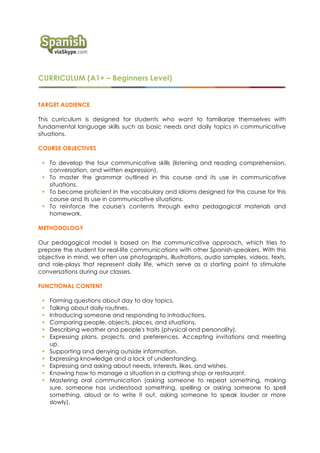
Spanish course for beginners (A1+)
- 1. CURRICULUM (A1+ – Beginners Level) TARGET AUDIENCE This curriculum is designed for students who want to familiarize themselves with fundamental language skills such as basic needs and daily topics in communicative situations. COURSE OBJECTIVES ! To develop the four communicative skills (listening and reading comprehension, conversation, and written expression). ! To master the grammar outlined in this course and its use in communicative situations. ! To become proficient in the vocabulary and idioms designed for this course for this course and its use in communicative situations. ! To reinforce the course's contents through extra pedagogical materials and homework. METHODOLOGY Our pedagogical model is based on the communicative approach, which tries to prepare the student for real-life communications with other Spanish-speakers. With this objective in mind, we often use photographs, illustrations, audio samples, videos, texts, and role-plays that represent daily life, which serve as a starting point to stimulate conversations during our classes. FUNCTIONAL CONTENT ! Forming questions about day to day topics. ! Talking about daily routines. ! Introducing someone and responding to introductions. ! Comparing people, objects, places, and situations. ! Describing weather and people's traits (physical and personality). ! Expressing plans, projects, and preferences. Accepting invitations and meeting up. ! Supporting and denying outside information. ! Expressing knowledge and a lack of understanding. ! Expressing and asking about needs, interests, likes, and wishes. ! Knowing how to manage a situation in a clothing shop or restaurant. ! Mastering oral communication (asking someone to repeat something, making sure. someone has understood something, spelling or asking someone to spell something. aloud or to write it out, asking someone to speak louder or more slowly).
- 2. GRAMMATICAL CONTENT * Nouns - Gender: how to distinguish the gender according to the ending of a word. - Common irregular words. Gender of nouns when referring to people (professions, relatives, etc.). Articles - Morphology. Elisions. - Presence and absence: General rules. Common irregular articles: in common uses; with time markers; with hay/está. Pronouns - Questions (qué, por qué, cómo, dónde, cuándo, etc.). - Personal pronouns. Functions: subject and direct object: presence, absence, and collocation. Being able to give examples and recognize pronouns when they function as direct objects. - Common relative pronouns (que). Adverbs - Quantity: mucho, bastante, poco, etc. - Comparatives. - Affirmation/negation. Adjectives - Descriptive. - Adjectives describing origins. - Gender and number. Agreement. - Comparatives to describe superiority and inferiority. Numerals - Formation and agreement of ordinal and cardinal numbers. - Common weights and measurements. - Numerals to a million: examples and recognition. - Plural formation. - Agreement. Demonstrative pronouns - Morphology and its used to identify, show, and distinguish. Possessives - Stressed and unstressed forms. - General uses: identification, ownership. - Interchanging articles and possessives. Prepositions and prepositional expressions. Indefinite and quantitative articles - Morphology and most commonly used articles. - Shortened forms. - Differences between algo/nada.
- 3. Key words - Indicators of the present time. - Indicators of location. - Expressions of time, days of the week, months, dates, and seasons of the year. Modes and Verb tenses - Subject-verb and attribute agreement. - Ordering and placement of words in a sentence. - Present indicative (common, regular and irregular verbs). - The use of present tense as imperative. - Reflexive verbs. - Uses of ser, estar, tener, hacer and haber. - Quedar bien/mal. - Morphology of the following verbs: gustar , encantar, parecer and interesar. - Periphrastic verbs: ir a + infinitive, tener que + infinitive, haber que + infinitive, estar + gerund. - Uses of ser and estar: - Ser + adjective - Ser to tell time and in reference to time - Estar + temporal adverbs - Estar to describe the location of people and objects Sentence construction - Affirmative sentences. - Asking direct questions. - Using common conjugations. - Comparative. - Causal sentences and final sentences (porque, para + infinitive). - Adjective sentences beginning with common relative pronouns (que, donde...) and with the verb in the indicative form. * - If the student requests grammatical content from lower levels, can be reviewed (descriptive adjectives, demonstrative pronouns, numerals, indicators of present tense, etc.).
